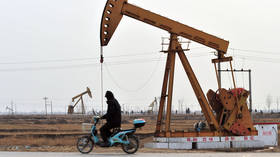Is the real reason the US is so interested in what’s going on in Xinjiang because it contains so much oil?
is a British writer and analyst of politics and international relations with a primary focus on East Asia.

Last week, China made a significant announcement that went somewhat under the radar. In the Xinjiang autonomous region in the far west, its oil companies have discovered an oil reserve that amounts to nearly one billion tons. This is the largest found in China in decades, and adds to an ever-growing number of discoveries in this region.
While it may not be a complete gamechanger, given China is, by some distance, the world’s largest consumer of crude oil, with a booming industrial economy and 1.4 billion people, the find is clearly important nonetheless.
Beijing is on a quest not just for mere energy, but for ‘energy independence’ – the idea that a country does not need to rely on others for its power and fuel. But the question is why is this such a priority?
While the reality is that China as a whole will never have the oil reserves to be completely free from relying on others, and is currently dependent on extensive imports from the Middle East, in Beijing’s eyes, the status quo isn’t tenable.
The traditional route of importing oil across the Indian Ocean, through the Strait of Malacca and up through the South China Sea, is at the mercy of the United States, which, through its ‘free and open Indo-Pacific’ strategy, is aiming to military encircle China via the water around it.
There’s a hypothetical fear that, in a conflict, Washington could embargo shipping routes from beyond China’s periphery and, by extension, cut off oil imports. It would be a quick route to crippling Beijing, if the US were to pull it off.
This consideration has transformed Xinjiang into one of the most strategically important regions in China, not just for Beijing but for its enemies too. It’s a lynchpin, not just in terms of its vast energy resources, but also in its geographical importance as a gateway to the West, towards central Europe, and the Middle East.
ALSO ON RT.COMChina’s new partnership with Iran is not a full alliance, but enough to undermine US sanctions & rock global status quoSouth of the region sits Pakistan, which produces a straight corridor to the western Indian ocean, bypassing the Indian subcontinent and is ideal for importing oil. This underlines the importance of the China-Pakistan Economic Corridor and the Belt and Road Initiative (BRI) as a whole.
What’s clear is that Xinjiang is absolutely crucial to China’s energy dependence and diversification strategies – and it’s difficult for the US to militarily get at it.
But it is trying to counter China by a variety of means. While there is the corporate element of maintaining hegemony over the global oil industry – the United States doesn’t like countries it cannot control to possess oil – its objectives are primarily military-strategic.
First, the US has put Chinese oil companies on its entity list in an attempt to block them from acquiring advanced oil exploration technology (although this appears to have failed). It has also placed them on the investment ban list, in an attempt to deprive them of American capital.
However, these efforts are piecemeal when you consider the broader bid to try to geopolitically isolate the Xinjiang autonomous region completely by propagating claims of a genocide there against the Uighur minority, with the objective of aiming to undermine supply chains and investment within it. This is all with the goal of forcing China to rely on its maritime periphery, and raising the political costs of Beijing keeping the tightly controlled status quo.
But this doesn’t seem to be affecting Beijing’s focus on energy dependency. Over the weekend, China discovered one of the largest shale-oil deposits in the world near Inner Mongolia. This will complement a variety of other alternative energy efforts, including massive investment in electric cars, buses and batteries; an enormous drive towards nuclear power and technology; a proposal to extract uranium from the sea; the construction of new pipelines with Russia; and a strengthening of the relationship with Iran to coincide with the BRI land routes.
In every area, China is aggressively diversifying and investing in various means of energy in the bid to patch up this massive strategic vulnerability. The battle also extends to the South China Sea region, which contains 14 trillion barrels of oil and natural gas. But with this area being politically contested, this is a long-term option and not an immediate solution.
And so, in the short term, Xinjiang and its associated trade routes and energy reserves are essential in China’s bid to strategically rewire its supply routes away from militarily contentious regions and prepare for more confrontation with the US. If China succeeds in doing this, it will feel empowered to take a harder line on the sea.
It’s no wonder, then, that the US has hammered the Xinjiang issue so aggressively. With America having a history of weaponizing propaganda in the bid to strategically dominate oil reserves, it should surprise nobody… yet nothing it has done so far has managed to slow down China’s efforts.
The statements, views and opinions expressed in this column are solely those of the author and do not necessarily represent those of RT.


0 Comments:
Post a Comment
Subscribe to Post Comments [Atom]
<< Home